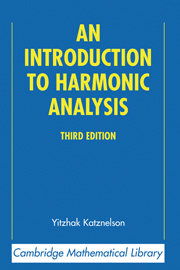Book contents
- Frontmatter
- Contents
- Preface
- Symbols
- AN INTRODUCTION TO HARMONIC ANALYSIS
- I Fourier Series on T
- II The Convergence of Fourier Series
- III The Conjugate Function
- IV Interpolation of Linear Operators
- V Lacunary Series and Quasi-analytic Classes
- VI Fourier Transforms on the Line
- VII Fourier Analysis on Locally Compact Abelian Groups
- VIII Commutative Banach Algebras
- A Vector-Valued Functions
- B Probabilistic Methods
- Bibliography
- Index
Preface
Published online by Cambridge University Press: 05 June 2012
- Frontmatter
- Contents
- Preface
- Symbols
- AN INTRODUCTION TO HARMONIC ANALYSIS
- I Fourier Series on T
- II The Convergence of Fourier Series
- III The Conjugate Function
- IV Interpolation of Linear Operators
- V Lacunary Series and Quasi-analytic Classes
- VI Fourier Transforms on the Line
- VII Fourier Analysis on Locally Compact Abelian Groups
- VIII Commutative Banach Algebras
- A Vector-Valued Functions
- B Probabilistic Methods
- Bibliography
- Index
Summary
Harmonic analysis is the study of objects (functions, measures, etc.), defined on topological groups. The group structure enters into the study by allowing the consideration of the translates of the object under study, that is, by placing the object in a translation-invariant space. The study consists of two steps. First: finding the “elementary components” of the object, that is, objects of the same or similar class, which exhibit the simplest behavior under translation and which “belong” to the object under study (harmonic or spectral analysis); and second: finding a way in which the object can be construed as a combination of its elementary components (harmonic or spectral synthesis).
The vagueness of this description is due not only to the limitation of the author but also to the vastness of its scope. In trying to make it clearer, one can proceed in various ways; we have chosen here to sacrifice generality for the sake of concreteness. We start with the circle group T and deal with classical Fourier series in the first five chapters, turning then to the real line in Chapter VI and coming to locally compact abelian groups, only for a brief sketch, in Chapter VII. The philosophy behind the choice of this approach is that it makes it easier for students to grasp the main ideas and gives them a large class of concrete examples which are essential for the proper understanding of the theory in the general context of topological groups.
- Type
- Chapter
- Information
- An Introduction to Harmonic Analysis , pp. xi - xivPublisher: Cambridge University PressPrint publication year: 2004

